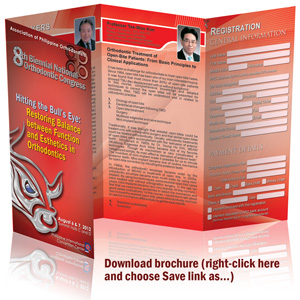Theme: “Hitting the Bull’s Eye – Restoring Balance Between Function and Aesthetics in Orthodontics”
SPEAKERS:
 Dr. Kazumi Ikeda
Dr. Kazumi Ikeda
Nihon University School of Dentistry
Orthodontic Course, University of Pennsylvania 1981
Founder and President of Roth Williams International
Society of Orthodontists
ABO Diplomate
TMJ 1st Orthodontics
Orthodontists all over the world diagnose cases by looking at Angle’s molar relationship and how the anterior teeth bite on hand-held models. We have been doing this for 100 years — it is a rigid tradition. Angle classification is mainly a two-dimensional, antero-posterior analysis. However, once we start to focus more on TMJs, we start unveiling patients’ real problem in three dimensions. Patients may be able to bite in centric occlusion where their teeth fit best while condyles are out of TMJ fossae, and many orthodontists are not paying enough attention to the joint, which closely associated with occlusion in the mouth. It is problematic to diagnose 3-D problem cases with 2-D analysis. People may say, “TMJ problem is for adults.” On the contrary, if you look at recent studies made by Nebbe and Major about prevalence of disc displacement among young pre-orthodontic patients, they show that about 85% of girls and 60% of boys already have disc displacement. In my practice, the prevalence of disc displacement is about 75% among 199 patients under age of 15 based on MRI data. As you know, TMJ internal derangement typically results from disc displacement, and joint problem is therefore quite common among young pre-orthodontic patients. How do you treat these patients who have joint problems to begin with? Among adult patients, it is even rarer to have healthy, normal joint.
So what should we do?
- Decenter orthodontists’ traditional Angle classification thought process
- Orthodontists should be a harmonizer between TMJ and teeth alignment in the mouth
- Understand clear-cut treatment goals in 5 areas such as facial esthetics, dental esthetics, functional occlusion, periodontal tissue, and TMJ.
 Professor Tae-Woo Kim, DDS, MSD, PhD
Professor Tae-Woo Kim, DDS, MSD, PhD
Professor Department of Orthodontics
School of Dentistry, Seoul National Dentistry
Vice President, Korean Association of Orthodontists
Orthodontic Treatment of Open-Bite Patients: From Basic Principles to Clinical Applications
It has been a challenge for orthodontists to treat open bite cases. Since 1984, open bite has been one of my main interested topics. It was found that most (more than 80%) of open bite patients showed ‘TMJ disc displacement with or without symptoms’.
In this course, comprehensive knowledge and detailed techniques to correct the open bites will be presented for clinicians. Also, TMD will be understood well in related to Orthodontic practice.
- Etiology of open bite
- Dentofacial changes following TMD
- Open bite treatment
Surgery
Multiloop edgewise arch wire technique
Mini-implant technique
Traditionally, it was thought that skeletal open-bites could be treated ony with orthognathic surgery and taht dental open-bites could be treated orthodontically. Usually, orthodontic treatments of open-bites were accomplished with the ‘extrusion anterior teeth’. Introduced in 1980s by Dr. Yong Ho Kim, MEAW (Multiloop Edgewise Arch Wire) became one of my favorite techniques. Though its mechanism is very complicated, if categorized simply, its main effect is ‘extrusion of anterior teeth’. The invention of mini-implant made it possible for us to intrude posterior teeth. Mini-implant became one of routine mechanics for open-bite correction by intruding the posterior teeth.
In 1980s, the orthodontic envelope became wider by the introduction of MEAW in treatment of open bite. In 2000s, orthodontic envelopebecame ven much wider by using mini-implant. By using two techniques, some skeletal open bite cases were treated well without orthognatic surgery. In the lasr ten years, mini-implants became very very popular. At this moment, I feel that we need some guidelines to select the mechanics and good cases (indications). In this course, I would like to talk about how to treat skeletal open-bite cases orthodontically and how to use two mechanics differentially to get the best results.
- Retention and stability
- Summary
Download brochure and registration form here. (Right-click and choose Save link as…)





 Views Today : 880
Views Today : 880 Total views : 6825265
Total views : 6825265